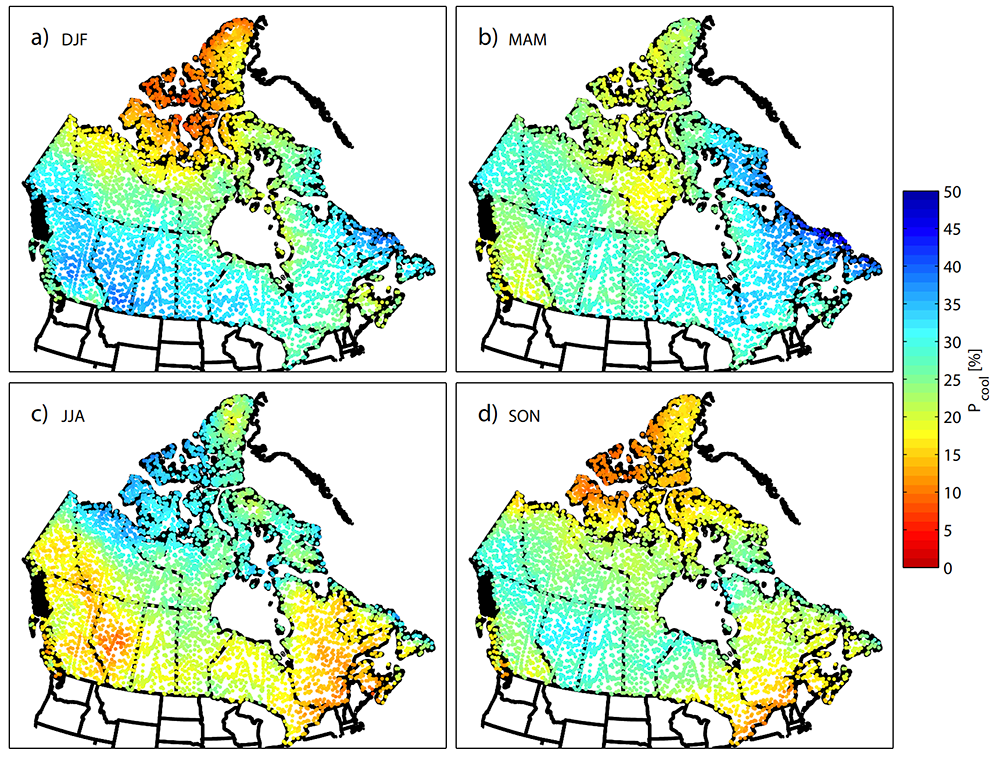Probability of temporary local cooling
The published journal article is designed to enlighten researchers and decision-makers working in the areas of vulnerabilities, impacts and adaptation about the role of natural variability in climate evolution, which is preventing climate warming caused by human activities occuring gradually.
Project details
Principal(s) investigator(s)



Context
Even under the climate-dominant action of greenhouse gases, air temperature at the surface may undergo relatively long periods of temporary cooling. This holds true at the global level but is even more relevant at the regional or local levels as climate is more variable on small spatial scales. T
aking into consideration a large set of numerical simulations, it is possible to estimate the probability that a given location will undergo temporary cooling. Across the Canadian territory during the 2006-2035 period, the probability that annual temperatures will decline ranges approximately within 40% to 46% for a 5-year duration, as opposed to 2% to 18% for a 25-year duration. This is consistent with a warming trend over the longer term.
The results of this project underscore the importance of natural climate variability and indicate that a temporary cooling trend does not contradict the observed and projected warming trend.
Objective(s)
-
Explain the consistency between a temporary cooling trend and long-term warming. Illustrate the importance of considering climate variability in the short-term adaptation process.
-
Estimate the likelihood that a cooling trend lasting for 5 to 25 years will occur during the 2006-2035 period, across Canada and for each season.
-
Study the impact of the climate scenario construction method on the results.
Methodology
-
Interpolate 60 global climate simulations representing 15 numerical models and 4 emission scenarios on a grid covering Canada.
-
Construct climate scenarios by statistically adjusting the simulations based on an observational product.
-
Calculate the probability of cooling by locality and by season.
-
Write a scientific journal article.
Results
The probabilities were obtained from 60 simulations, i.e. 4 for each of the following 15 global models: FGOALS-s2, MIROC5, MRI-CGCM3, HadGEM2-AO, GFDL-ESM2M, HadGEM2-ES, FIO-ESM, NorESM1-M, MIROC-ESM-CHEM, CSIRO-Mk3-6-0, GISS-E2-R, CCSM4, GFDL-ESM2G, MIROC-ESM and GFDL-CM3. Each simulation of a model is based on one of the emission scenarios (RCP2.6, RCP4.5, RCP6.0 or RCP8.5); equal weight is assigned to each of the 60 simulations. Once every simulation has been used to construct a climate scenario, the occurrence frequency of negative linear trends for a given duration (5, 10, 15, 20 or 25 years) during the 2006-2035 period is interpreted as the cooling probability. This interpretation is based on the principle that the more frequently a phenomenon (such as cooling) is simulated by climate models, the more plausible it should be considered for the real atmospheric system.
Calculations are carried out independently for each of the points of a grid covering Canada. Figure 1 below shows the cooling probabilities for a 20-year period, as obtained for each season. In general, probabilities approaching 50% denote with very strong interannual climate variability relative to the background signal (long-term trend), as is the case for Labrador in winter (DJF stands for December-January-February). Conversely, low probabilities indicate a strong warming signal relative to interannual variability, as is the case for the extreme south of Quebec in fall (SON stands for September-October-November).

Figure 1. Probability of local cooling over 20 years, across Canada and during the 2006-2035 period. Probabilities are presented by season: a) winter (DJF), b) spring (MAM), c) summer (JJA), and d) fall (SON).
Benefits for adaptation
Benefits for adaptation
The published journal article is designed to enlighten researchers and decision-makers working in the areas of vulnerabilities, impacts and adaptation about the role of natural variability in climate evolution, which is preventing climate warming caused by human activities occuring gradually.
Canadian regions with a strong probability (approaching 50%) of experiencing temporary cooling trends were identified for each of the seasons.
The project also sets out an argument against any questioning on global warming based, for example, on the fact that global temperatures experienced slowdown during the first decade of the 21st century or the fact that there are occasional record-breaking cold temperatures.